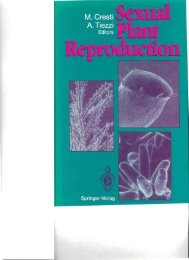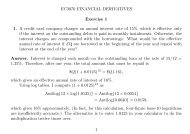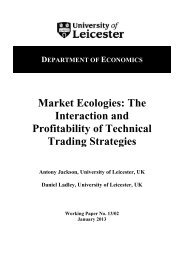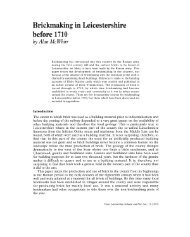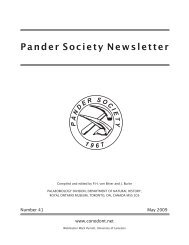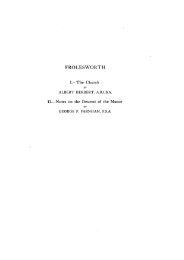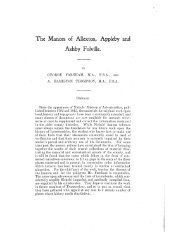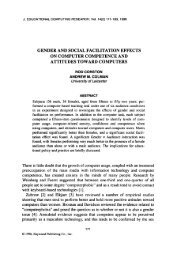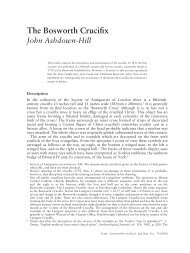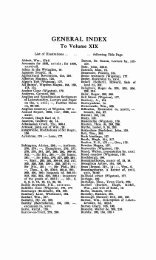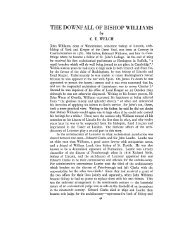Pander Society Newsletter - University of Leicester
Pander Society Newsletter - University of Leicester
Pander Society Newsletter - University of Leicester
Create successful ePaper yourself
Turn your PDF publications into a flip-book with our unique Google optimized e-Paper software.
Veronica Castelló. Starting on Ph.D. studies involving the Frasnian-Fammenian boundary in the Pyrenees<br />
(Supervisor Dr. Jose Ignacio Valenzuela Rios).<br />
Ronald R. Charpentier. Not presently active in conodont research.<br />
David L. Clark. Nothing to report on the conodont front. Please note new e-mail address.<br />
Damian Cole. Activities include continued sampling <strong>of</strong> limestones and cherts in the area surrounding<br />
Bungonia in southeastern NSW, Australia.<br />
Carlo Corradini. Continuing research on Silurian and Devonian conodont biostratigraphy in Sardinia and<br />
in the Carnic Alps. Investigating the Ockerkalk facies limestones and a paper on graphic correlations based<br />
on sections in this unit in Sardinia is ‘In Press’ (with S. Gouwy); a revision <strong>of</strong> the Famennian-Tournaisian<br />
conodont biostratigraphy in the island is completed. Investigating the Silurian-Lower Devonian Orthoceras<br />
limestones in several areas <strong>of</strong> the Italian side <strong>of</strong> the Carnig Alps.<br />
James (Jed) Day. Continuing field-based research (with Jeff Over, Michael Whalen) on integrated<br />
brachiopod-conodont biostratgraphy <strong>of</strong> Middle and Upper Devonian carbonate platform (carbonate ramp<br />
and detached reef platforms) and basin sequences in the Canadian Rocky Mountain outcrop in western<br />
Alberta and eastern British Columbia. Recent work in eastern B.C. appears to indicate that the initial<br />
Devonian marine transgression and flooding <strong>of</strong> the West Alberta Arch and Peace River Arch was likely<br />
much earlier (as old as Upper varcus Zone) than in areas to the east in Alberta (Upper disparilis Zone).<br />
Continuing work on the late Givetian-Frasnian Iowa Basin conodont-brachiopod sequences and will<br />
present results <strong>of</strong> continuous conodont sampling through the interval <strong>of</strong> the middle Givetian varcus Zone to<br />
early Frasnian Montagne Noire Zone 4. This sequence provided conodont apatites analyzed for the study <strong>of</strong><br />
stable oxygen and carbon isotope chemostratigraphy through the late Givetian-early Frasnian transition in<br />
Joachimski et al. (2004). The basic features <strong>of</strong> the sequence will be presented in the guidebook for the 2006<br />
Great Lakes Section <strong>of</strong> SEPM Fall Field Conference.<br />
Xiping Dong. Continues to study Cambrian through Lower Ordovician conodonts from Hunan, Anhui,<br />
Zhejiang, south China and Liaoning, Shandong, north China, and Zinjiang, northwest China. Also has been<br />
collaborating with S. Bergström and J. Repetski on the Cambrian though Lower Ordovician conodonts<br />
from western Hunan. Since 2000, has been working with P. Donoghue on the histology and comparative<br />
histology <strong>of</strong> protoconodonts, paraconodonts and the earliest euconodonts from China.<br />
Philip Donoghue. Dong Xiping and I have been continuing our work on Cambrian paraconodont and<br />
euconodont histology and evolution. Together with Mark Purnell, Dick Aldridge & Zhang Shunxin we<br />
have submitted manuscripts on the cladistic relations <strong>of</strong> “complex” conodonts .<br />
Jolanta Dopieralska. Continuing studies on REE isotope chemistry <strong>of</strong> conodonts. Several studies on<br />
seawater geochemistry and circulation in the Variscan Sea during the Late Devonian are complete. Last<br />
year I moved from Giessen (Germany) to a new isotope laboratory at the Adam Mickiewicz <strong>University</strong> in<br />
Poland.<br />
Julie A. Dumoulin. Have been working with Anita Harris for a number <strong>of</strong> years using conodonts to<br />
investigate the age, depositional settings, and thermal level <strong>of</strong> Cambrian through Triassic rocks in Alaska,<br />
especially Ordovician through Pennsylvanian strata in northern Alaska. My most recent research has<br />
focused on the Carboniferous-Permian Lisburne Group.<br />
Michiel Dusar. Presently not working with conodonts but more generally with regional upper Palaeozoic<br />
stratigraphy.<br />
Jerzy Dzik. Continuing studies on Late Devonian conodont apparatuses. Have submitted a monograph on<br />
Famennian conodonts from Poland (142 apparatus species) to Palaeontologia Polonica.<br />
Raymond L. Ethington. Continue to compile a catalogue <strong>of</strong> the conodonts in the <strong>University</strong> <strong>of</strong> Missouri<br />
Collection, having finished with the Branson/Mehl/Ellison era and am well into the Ethington/Clark and<br />
fellow travellers portion. Work continues sporadically on several long-standing Ordovician projects, but I<br />
find that retirement provides just as many distractions as working. One <strong>of</strong> such has been assisting K.<br />
MacLeod & D. Bassett in their efforts to extract Ordovician temperature information from oxygen isotope<br />
ratios in conodonts.<br />
Silvia Blanco Ferrera. I am working in conodont and stratigraphy from the Tournaisian to the Bashkirian<br />
<strong>of</strong> the Iberian Peninsula. CAI research is focusing in the Cantabrian Zone and the Pyrenees.<br />
Barry Fordham. Working on Ordovician to Carboniferous conodonts from Queensland, Australia.<br />
Although I am now involved in sustainability science, I am still working on conodonts in my spare time.<br />
Susana Garcia-López. Working on Silurian to Lower Carboniferous conodonts, mainly focusing on<br />
biostratigraphy and bi<strong>of</strong>acies. Also actively working on projects dealing with CAI research in the<br />
Cantabrian Zone and Pyrenees (NW & NE <strong>of</strong> Spain).<br />
14



